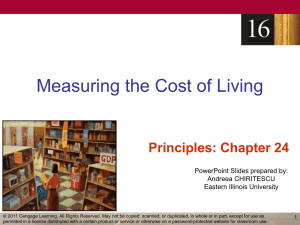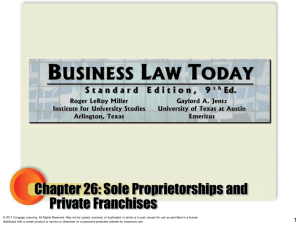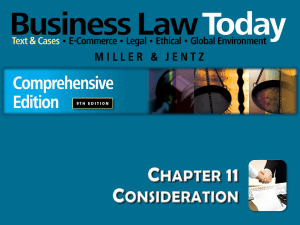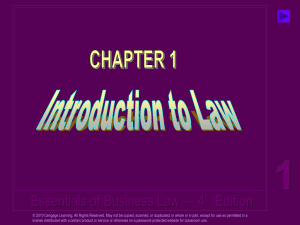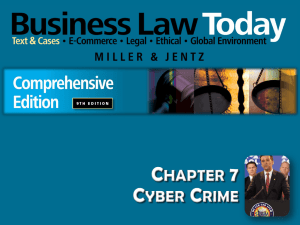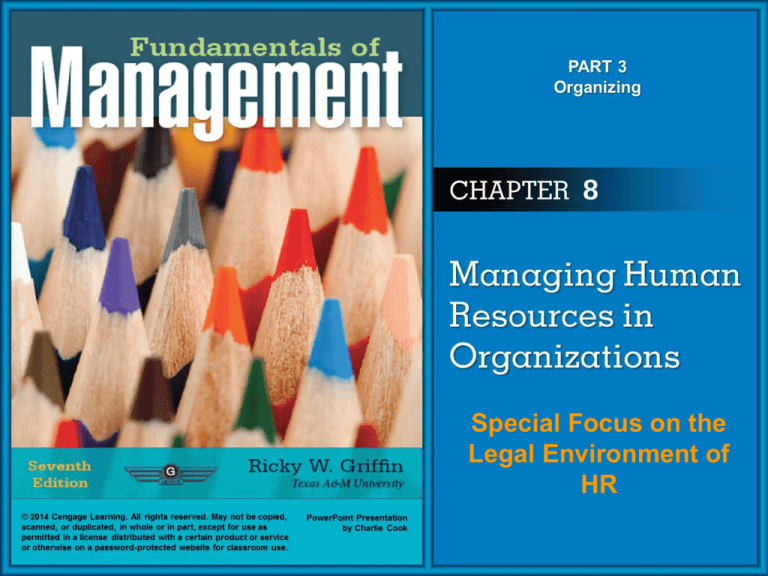
Special Focus on the
Legal Environment of
HR
Chapter Learning Objectives
After studying this chapter you should be able to:
1. Describe the environmental context of human resource
management, focusing on the legal and social factors.
2. Know the key HR/ EEO laws and landmark cases.
3. Be able to interpret and apply law and court decisions to
practical workplace decision-making, such as recruiting
and hiring, training, compensation, promotions, pay, and
terminations.
8–2
The Environmental Context of
Human Resource Management
• Human Resource Management (HRM)
–The set of organizational activities directed at
attracting, developing, and maintaining an effective
work force.
• The Strategic Importance of HRM
–Human capital reflects the organization’s investment
in attracting, retaining, and motivating an effective
workforce critical for effective organizational
functioning.
© 2014 Cengage Learning. All rights reserved. May not be copied, scanned, or duplicated, in whole or in part, except for use as
permitted in a license distributed with a certain product or service or otherwise on a password-protected website for classroom use.
8–3
The Legal Environment of HRM
Equal Employment
Opportunity
Compensation
and Benefits
Labor
Relations
Health
and Safety
Title VII of Civil
Rights Act of 1964
Fair Labor
Standards Act of
1938 (FLSA)
National Labor
Relations Act of
1935 (Wagner Act)
Occupational
Safety and Health
Act of 1970 (OSHA)
Equal Pay Act
of 1963
Labor Management
Relations Act
of 1947
(Taft-Hartley Act)
Pregnancy
Discrimination Act
Age Discrimination
in Employment Act
Americans with
Disabilities Act
Employee
Retirement Income
Security Act of
1974 (ERISA)
Civil Rights Act
of 1991
Family and Medical
Leave Act of 1993
(FMLA)
Executive Order
11246 – Affirmative
Action
Affordable Care Act
(ACA)
© 2014 Cengage Learning. All rights reserved. May not be copied, scanned, or duplicated, in whole or in part, except for use as
permitted in a license distributed with a certain product or service or otherwise on a password-protected website for classroom use.
8–4
Equal Employment Opportunity
• Title VII of the Civil Rights Act of 1964
–Forbids discrimination in the employment relationship.
8–5
Civil Rights Act of 1964
Title VII, section 703 (g)
“It shall be an unlawful employment practice
for an employer to fail or refuse to hire, or to
discharge an individual or otherwise to
discriminate against any individual with
respect to his compensation, terms,
conditions, or privileges of employment,
because of such an individual’s race, color,
religion, sex, or national origin.”
8-6
Civil Rights Act of 1964
• Define “discriminate”.
• Is all discrimination illegal?
• What are the five protected class of Title VII?
• What is “disparate treatment”?
• What is “disparate impact”?
8-7
Civil Rights Act of 1964 – example landmark decisions
(case law)
Race Discrimination
–Griggs v. Duke Power
–Spurlock v. United Airlines
Sex Discrimination
–Diaz v. Pan Am
–Phillips v. Martin Marietta
National Origin, Religion, Color Discrimination
8-8
Civil Rights Act of 1964
• BFOQ
–What is it? Where is it allowed?
–The Hooters case
–http://blogs.findlaw.com/free_enterprise/2009/04/canmen-be-hooters-girls-when-can-businesses-hire-onlywomen.html
• EEOC – Equal Employment Opportunity
Commission
–Federal agency charged with enforcing Title VII as
well as several other employment-related laws.
–Process Complaints
–Issue Guidelines
9-9
Age Discrimination in Employment Act of
1967
• Age Discrimination in Employment Act of 1967
–Outlaws discrimination against people older than
40 years of age.
–Management Challenge: Can an employer at the
Career Fair tell you “well, we like your resume, but we
are looking for someone a little older”?
© 2014 Cengage Learning. All rights reserved. May not be copied, scanned, or duplicated, in whole or in part, except for use as
permitted in a license distributed with a certain product or service or otherwise on a password-protected website for classroom use.
8–10
Executive Order 11246
• Affirmative Action
–The commitment of employers to proactively seek out,
assist in developing, and hire employees from groups
that are underrepresented in the organization.
–Various executive orders, especially Executive Order
11246, require federal contractors to develop
affirmative action plans and engage in affirmative
action in hiring veterans and the disabled.
–What is an underrepresented group?
–How does the employer document they are proactively
seeking and hiring underrepresented individuals?
© 2014 Cengage Learning. All rights reserved. May not be copied, scanned, or duplicated, in whole or in part, except for use as
permitted in a license distributed with a certain product or service or otherwise on a password-protected website for classroom use.
8–11
Equal Employment Opportunity (cont’d)
• Americans with Disabilities Act of 1990 (ADA)
–Forbids discrimination on the basis of disabilities and
requires employers to provide reasonable
accommodations for disabled employees.
• What constitutes a disability?
• What constitutes reasonable accommodation?
• Civil Rights Act of 1991
–Amended the original Civil Rights Act, making it easier
to bring discrimination lawsuits while also limiting
punitive damages ( in addition to compensatory
damages) that can be awarded in those lawsuits.
© 2014 Cengage Learning. All rights reserved. May not be copied, scanned, or duplicated, in whole or in part, except for use as
permitted in a license distributed with a certain product or service or otherwise on a password-protected website for classroom use.
8–12
Compensation
• Fair Labor Standards Act of 1938 (FLSA)
–Sets a minimum wage and requires overtime pay for work
in excess of 40 hours per week.
– What is the minimum wage? Do all states comply?
– Are there any jobs with minimum wage exceptions?
– Salaried professional, executive, and administrative employees are
exempt from the Act’s minimum wage and overtime provisions. Who
is considered non-exempt? What does it mean to be non-exempt?
• Equal Pay Act of 1963
–Requires men and women to be paid the same amount
for doing the same jobs; exceptions are permitted for
seniority and performance pay.
© 2014 Cengage Learning. All rights reserved. May not be copied, scanned, or duplicated, in whole or in part, except for use as
permitted in a license distributed with a certain product or service or otherwise on a password-protected website for classroom use.
8–13
Benefits
• Employee Retirement Income Security Act
of 1974 (ERISA)
–Sets standards for pension plan management
and provides federal insurance if pension
plans go bankrupt.
• Family and Medical Leave Act of 1993
(FMLA)
–Requires employers to provide up to 12 weeks of
unpaid leave for family and medical emergencies.
• What constitutes “family”?
• What constitutes “medical emergencies”?
© 2014 Cengage Learning. All rights reserved. May not be copied, scanned, or duplicated, in whole or in part, except for use as
permitted in a license distributed with a certain product or service or otherwise on a password-protected website for classroom use.
8–14
8–15
Labor Relations
• National Labor Relations Act of 1935
(Wagner Act)
–Set up procedures for establishing unions and
requires employers to bargain collectively with unions.
• National Labor Relations Board (NLRB)
–Is the federal agency that enforces the NLRA.
• Labor Management Relations Act of 1947
(Taft-Hartley Act)
–Limited power of unions and increased management’s
rights during organizing campaigns.
© 2014 Cengage Learning. All rights reserved. May not be copied, scanned, or duplicated, in whole or in part, except for use as
permitted in a license distributed with a certain product or service or otherwise on a password-protected website for classroom use.
8–16
Health and Safety
• Occupational Safety and Health Act of 1970
(OSHA) requires that employers:
–Provide a place of employment that is free from
hazards that cause death or serious physical harm.
–Obey safety and health standards set by the
Occupational Safety and Health Administration
(OSHA).
• How does OSHA enforce safety standards?
• And if you don’t follow safety standards…
– Consequences?
© 2014 Cengage Learning. All rights reserved. May not be copied, scanned, or duplicated, in whole or in part, except for use as
permitted in a license distributed with a certain product or service or otherwise on a password-protected website for classroom use.
8–17
The Legal Environment of HRM (cont’d)
Emerging Legal Issues
Sexual
harassment
Alcohol
and drug
dependencies
AIDS in
the workplace
© 2014 Cengage Learning. All rights reserved. May not be copied, scanned, or duplicated, in whole or in part, except for use as
permitted in a license distributed with a certain product or service or otherwise on a password-protected website for classroom use.
8–18
Sexual Harassment – Guideline provided by the EEOC
• Quid Pro Quo & Hostile Environment
“Unwelcome sexual advances, requests for
sexual favors, and other verbal or physical
conduct of a sexual nature constitutes sexual
harassment when; (1) submission to such
conduct is made either explicitly or implicitly a
term or condition of employment, (2) submission
to or rejection of such conduct by an individual is
used as the basis for employment decisions, or
(3) such conduct has the purpose or effect of
unreasonably interfering with an individual’s
work performance, or creating an intimidating,
hostile, or offensive environment.”
Landmark case: Meritor v. Vinson
8-19
Sexual Harassment
It is your job as a manager to advise your
employees regarding behavior that might be
construed as sexual harassment. What
behavior should you tell your employees to
avoid?
1.__________________
4._______________
2.__________________
5._______________
3.__________________
6._______________
8-20
HR & The Legal Environment
• Will you likely practice HR functions in your
career, even if you are not in the HR
department?
• Why do you need to be aware of legal issues
involving HR?
8-21






